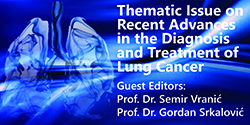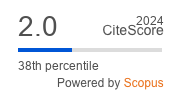Extent of subarachnoid hemorrhage and development of hydrocephalus
Keywords:
Hydrocephalus, Subarachnoid hemorrhage, Fisher scaleAbstract
Background and objective Factors associated with the developmentof acute hydrocephalus following subarachnoidhemorrhage are not fully elucidated. The goal of this studywas to present the relative predictive values of Hunt-Hessgrade and Fischer score in determining the propensity fordeveloping post-hemorrhage hydrocephalus and to documentthe frequency of acute and chronic hydrocephalus followingsubarachnoid hemorrhage. Patients and methodsOur study encompassed 102 patients with anurismal subarachnoidhemorrhage. The Hunt-Hess scale was used forthe initial neurological status assessment and the extent ofsubarachnoid hemorrhage was graded based on the Fisherscale. Assessment of hydrocephalus was made on the basisof the size of both temporal horns, the ratio of FH/ID andEvan’s ratio. Results Thirty-two percent of patients exhibitedhydrocephalus requiring CSF diversion procedure. Externalventricular drainage was performed in 29 % of patients forearly hydrocephalus. Seventy percent of patients with acutehydrocephalus requiring external ventricular drainage weregraded as 3, 4 or 5 according to the Hunt and Hess scale onadmission, in contrast to 58 percent of patients without hydrocephalus.Ninety-three percent of patients with hydrocephaluswere graded as 3 and 4 according to Fisher grade oninitial CT scan, in contrast to 83% of patients without hydrocephalus.Conclusion Even though an increased frequency ofhydrocephalus was noted among patients that presented withhigher Fisher and Hunt-Hess grades, none of these gradeswere shown to bear a statistically significant predictive valuein determining the propensity for the development of hydrocephalus.References
Aoyagi N, Hayakawa I. Study on early re-rupture of intracranial aneurysms. Acta Neurochir. 1996;138:12–8.
Sheehan JP, Polin RS, Sheehan JM, Baskaya MK, Kassell NF. Factors associated with hydrocephalus after aneurysmal subarachnoid hemorrhage. Neurosurgery. 1999;45(5):1120-8.
Hirashima Y, Hamada H, Hayashi N, Kuwayama N, Origasa H, Endo S. Independent Predictors of Late Hydrocephalus in Patients with Aneurysmal Subarachnoid Hemorrhage - Analysis by Multivariate Logistic Regression Model. Cerebrovascular Diseases. 2003;16:205-10.
Bakker AM, Mees SMD, Algra A, Rinkel GJE. Extent of acute hydrocephalus after aneurysmal subarachnoid hemorrhage as a risk factor for delayed cerebral infarction. Stroke. 2007;38:2496-9.
Ohwaki K, Yano E, Nakagomi T, Tamura A. Relationship between shunt-dependent hydrocephalus after subarachnoid haemorrhage and duration of cerebrospinal fluid drainage. British Journal of Neurosurgery. 2004;18(2):130-5.
Gruber A, Reinprecht A, Bavinzski G, Czech T, Richling B. Chronic shunt-dependent hydrocephalus after early surgical and early endovascular treatment of ruptured intracranial aneurysms. Neurosurgery. 1999;44(3):503-12.
Hunt WE, Hess RM. Surgical risk as related to time of intervention in the repair of intracranial aneurysms. J Neurosurg. 1968;28:14-9.
Fisher CM, Kistler JP, Davis JM. Relation of cerebral vasospasm to subarachnoid hemorrhage visualized by computerized tomographic scanning. Neurosurgery. 1980;6(1):1-9.
Kassell NF, Torner JC, Haley EC, Jane JA, Adams HP, Kongable GL. The International Cooperative Study on the Timing of Aneurysm Surgery. Part 1: Overall management results. J Neurosurg. 1990;73:18-36.
Kassell NF, Torner JC, Jane JA, Haley EC, Adams HP. The International Cooperative Study in the Timing of Aneurysm Surgery. Part 2: Surgical results. J Neurosurg. 1990;73:37-47.
De Oliveira JG, Beck J, Setzer M, Gerlach R, Vatter H, Seifert V, Raabe A. Risk of shunt-dependent hydrocephalus after occlusion of ruptured intracranial aneurysms by surgical clipping or endovascular coiling: a single-institution series and
meta-analysis.Neurosurgery. 2007;61(5):924-34.
Katano H, Karasawa K, Sugiyama N, Yamashita N, Ohkura A, Kamiya K. Clinical evaluation of shunt implantations using Sophy programmable pressure valves: comparison with Codman–Hakim programmable valves. Journal of Clinical Neuroscience. 2003;10:557-61.
Roitberg BZ, Khan N, Alp MS, et al: Bedside external ventricular drain placement for the treatment of acute hydrocephalus. Br J Neurosurg. 2001;15:324–7.
McIver JI, Friedman JA, Wijdicks EFM, Piepgras DG, Pichelmann MA, Toussaint LG et al. Preoperative ventriculostomy and rebleeding after aneurysmal subarachnoid hemorrhage. J Neurosurg. 2002;97(5):1042-4.
Yoshimoto Y, Wakai S, Hamano M. External hydrocephalus after aneurysm surgery: paradoxical response to ventricular shunting. J Neurosurg. 1998; 88(3):485-9.
Kawai K, Nagashima H, Narita K. Efficacy and risk of ventricular drainage in cases of grade V subarachnoid hemorrhage. Neurol Res. 1997;19:649-53.
Hellingman CA, van den Bergh WM, Beijer IS, van Dijk GW, Algra A, van Gijn J, et al. Risk of Rebleeding After Treatment of Acute Hydrocephalus in Patients With Aneurysmal Subarachnoid Hemorrhage. Stroke. 2007;38(1):96-9.






